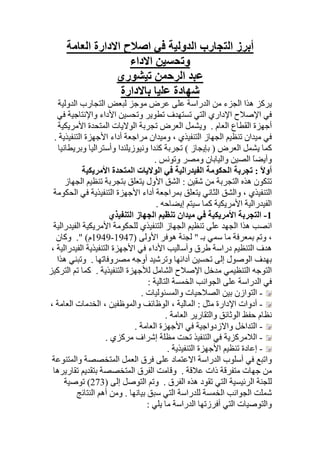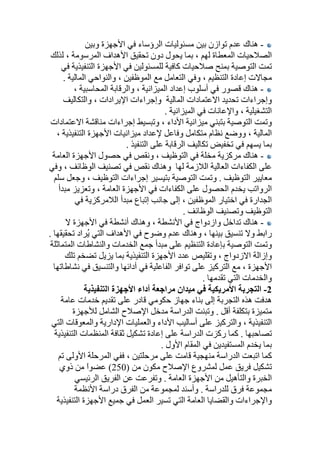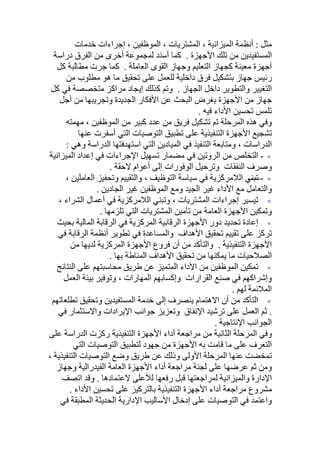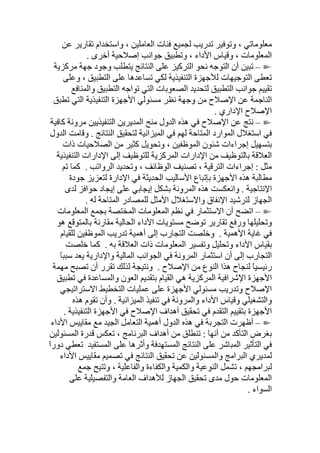???? ??????? ??????? ?? ????? ??????? ?????? ?????? ??????
Download as docx, pdf1 like2,051 views
?????? ??????? ??????? ?????? ?????? ???????? ???? ???? ???? ?? ???????? ???????? ????????? ???????? ??. ??? ????? ??? ?????? ?? ????? ???? ?????? ???????? ????? ???????. ??????? ????? ??????? ??????? ????????? ?? ??????.
1 of 6
Downloaded 78 times






Ad
Recommended
??? ????????? ?? ??????? ?????? ? ???????
??? ????????? ?? ??????? ?????? ? ???????BstdCC
?
????? ??????? ?????? ???????? ????????? ?? ??????? ???? ??? ????? ????????? ?????????? ??????? ?????? ???????? ?? ??????? ??????. ????? ????? ??? ??? ??? ?????? ??? ????????? ???????? ????? ??????? ????? ?????? ?????? ?????? ??? ??????? ????????. ???? ????? ????? ??? ???????? ???? ????? ???????? ?? ????? ????????? ?????? ???? ????? ????? ????.????? ???????
????? ???????Laith Alasadi
?
??????? ???? ?????? ??? ??????? ?? ??????? ?????? ????? ??????. ???? ????? ??????? ???????? ?????? ???????? ??????? ????? ????????? ?? ?????????? ??? ????? ??????? ???????? ?????? ?? ???? ??? ???????? ???????? ??????? ??? ???????. ??? ??????? ?????? ?????? ????? ?????? ???????? ??? ??????? ?????????.????? ??????? ?????? ???? ???????
????? ??????? ?????? ???? ??????????? ???????
?
??? ??????? ??????? ????? ???? ???? ??????? ?? ???? ? ?? ?????????? ??? ?? ??? ?????? ??????? ????????? ???????. ????? ??? ??????? ????? ?????????? ??????? ???????? ????? ?? ???????? ????? ?? ?????? ????? ????? ?? ??? ?? ??? ?????? ?? ????? ???????. ??? ???? ??????? ??? ????? ??????? ??????? ??? ?????? ???? ??????.??????? ????????
??????? ???????????? ??????? ?????????
?
?????? ??? ??????? ?????? ??????? ???????? ?????? ??????? ?????????? ??????? ?????? ???????? ?????????. ??? ?????? ???????? ???????? ???? ??? ?? ??????? ?????? ?????? ?????? ??????? ???????? ????????. ???? ??? ????? ???????? ???????? ?? ?????? ??????? ?????? ????? ??????? ??? ????????.Cross training program
Cross training programKathryn L Ramirez
?
The document describes a job shadowing program that allows employees to interact with more experienced professionals, receive feedback and support, and gain a broader perspective of the organization. The program benefits both prot¨¦g¨¦s through skills development and mentors through leadership development. It is intended to increase employee engagement, reduce turnover, and help with succession planning.??????? ???????
??????? ??????????? ??????? ?????????
?
???? ??????? ??? ????? ???? ????? ??? ??????? ???????? ?????? ????? ?????? ?????? ?? ????? ????? ????????? ?????????. ?????? ??????? ????? ????? ??????? ?????????? ????????? ?? ????? ???????? ????? ??? ????? ???????? ??????? ?????? ?????? ???????? ??????????. ??? ???? ??? ?????? ??????? ?? ????? ?????? ?????? ??????? ????.031 Front Line Leadership
031 Front Line LeadershipDr Fereidoun Dejahang
?
The document discusses FrontLine Leadership, a program that trains supervisors and frontline managers. The program covers core skills like giving feedback, managing individual and team performance, problem-solving, and managing change. It aims to improve outcomes like employee retention, productivity, and financial performance. The program teaches both managers and supervisors, with managers learning to support transferred skills and recognize employees.????? ???????
????? ???????MarwaBadr11
?
??????? ???? ???? ???? ????? ?????? ??????? ?????????? ?? ??????? ??? ????? ???????? ????????? ??????? ?? ???? ??????? ?????. ???? ??? ????? ?????? ?? ??????? ??????? ??????? ???????? ????? ????? ?????? ???????. ?????? ????? ???? ????? ?????? ??????? ?? ???? ??????????? ??????? ??????.?????? ??????? ???????????
?????? ??????? ??????????????? ??????? ?????????
?
?????? ??????? ????? ??????? ?????? ????? ???????? ???????? ??? ?????? ?? ???????? ??????????. ???? ?? ??????? ?? ????? ??????? ????? ?????? ?? ???????? ???????? ??????? ???????? ?????? ??????? ?????? ??????. ?????? ??????? ?? ??????? ???? ????? ??????? ?? ????? ??????? ?? ??????? ?????? ?????? ??? ??????? ???????? ???????? ???.??????? ???????????
??????? ???????????Waleed Hewala, MBA, PMP, ITIL
?
?????? ??????? ????? ??????? ??????????? ??????? ?? ????? ??????? ?????????? ???????? ?????? ????? ??????? ????????. ??? ???? ???????? ???????? ???? ????? ??????? ???????????? ????? ????? ?????? ???? ????? ?? ???????. ??????? ??? ????? ??????? ???????? ?? ??????? ????? ?? ????? ?????? ??????? ????????? ????????.Change management strategy_team_xyz
Change management strategy_team_xyzBao Nguyen
?
This document discusses three models of change management strategy for information systems (IS) specialists: the traditional IS model, the facilitator model, and the advocate model. The traditional model views technology as the driver of change and the IS specialist as an expert responsible only for technical matters. This can lead to reduced credibility and inhibit organizational change. The facilitator model sees people, not technology, as the drivers of change and positions the IS specialist as a facilitator of group processes to build user capacity. The advocate model positions the IS specialist as responsible for achieving organizational change through technology.?????? ???????? ??????? ???? ???????? ????????
?????? ???????? ??????? ???? ???????? ????????Ahmed Rezq
?
???? ?????? ???? ???????? ???????? ???? ??? ????? ???????? ???????? ???????? ?????? ????????? ?? ?????? ??????? ????????. ????? ???????? ??? ?????? ????? ???? ??????? ???????? ???????? ???????? ???????. ???? ???????? ??? ????? ?????? ????????? ??????? ????? ??? ?????? ?????? ?? ???????? ?????????.???? ???????? ???????
???? ???????? ???????Sameer Kau
?
±ľÎÄĽţĚ˝ĚÖÁË2010ÄęąÜŔí˛Ů×÷Ó빦ÄܵÄÇ÷ĘƺͼĽÄܵĹÜŔíŁ¬ÖصăąŘעĎŕąŘĽĽÄÜµÄżŞ·˘şÍÖŘŇŞĐÔˇŁĚÖÂŰÁËą¦ÄÜĐÔ˛Ů×÷şÍąÜŔíĽĽÄܵÄĎ໥ąŘϵŁ¬ŇÔĽ°Ç÷ĘƶÔδŔ´ąÜŔíµÄÓ°Ď졣ÎÄĽţÇżµ÷ÁËÔÚąÜŔíąýłĚÖжԼĽÄÜÓëÇ÷ĘƵÄČ«ĂćŔí˝âˇŁLeadership and change
Leadership and change Khalil Darvishali
?
1) The document discusses leadership, management, and change. It defines leadership as influencing others to achieve goals and management as accomplishing work through others.
2) Managing change in an organization is complex and often essential for development. Change can focus on structure, technology, people, or tasks.
3) For change to be successful there must be dissatisfaction with the current situation, a clear vision and model for change, an effective process, and resistance must be overcome.
4) The document also discusses charismatic leadership and how it differs from transformational leadership, with the latter focusing more on higher purpose and values rather than personal charm alone. ????? ?????? ?????? ?????
????? ?????? ?????? ????????? ??????? ?????????
?
?????? ??????? ????? ????? ?????? ?????? ?????? ?????? ????? ?????? ???????? ?????? ?? ??????. ???? ???????? ???? ?? ????? ????? ??????? ??? ?? ??? ???????? ?????? ?????????? ????????. ??? ?????? ????? ????? ?????? ???? ???????? ???????? ??? ??????? ??????? ??? ????? ?????.????? ?????? ?????????? ?????????
????? ?????? ?????????? ?????????MarwaBadr11
?
?????? ??????? ????? ?????? ?????????? ????????? ???????? ?? ???????? ?? ??????? ??? ??? ???????? ??????? ????????? ???????? ???????? ???. ???? ??????? ????? ??? ??????? ??? ???????? ?????? ??????????? ???????? ??? ??????? ?????? ??????? ????? ??? ??????. ????? ?? ????? ????? ????? ????? ???? ???????? ???????? ???? ????.Organizational Diagnosis
Organizational Diagnosisjim
?
The document discusses various organizational diagnosis and change models including McKinsey 7S model, Weisbord 6-box model, and systems theory. It also discusses the reflective learning model and how it is used in organizational diagnosis and change processes. Traditional problem-solving approaches are contrasted with solution-focused approaches like appreciative inquiry.????? ??????? ????????
????? ??????? ???????????? ??????? ????????
?
????? ??????? ????? ??????? ????????? ?? ???? ???????? ?? ??????? ??? ????? ???? ????? ??????? ???????? (MBO). ?????? ????? ????? ???????? ???????? ????????? ?????? ?????? ???????? ???? ???????? ???????? ?? ???? ??????? ???????? ???????? ?????????. ??? ??? ????? ????? ??? ????? ????? ???????? ??????? ??? ?????? ????? ?? ??????? ?????? ??????? ?????????.??????? ???????????????? ????? ???? ????
??????? ???????????????? ????? ???? ????AhmedRawhy1
?
???????? ???? ??? ????? ?????? ????????? ?? ??????? ??????????? ?? ???? ????? ??????? ?????? ????? ??? ???? ??????. ??? ????? ???????? ???????? ???????? ???????? ???????? ??????????? ???? ????? ??????? ???????. ????? ???????? ?????? ????? ?????? ????? ????? ?????? ????? ?????? ????? ??????? ?????????.??????? ????????????
??????? ???????????????? ??????? ?????????
?
??????? ???????????? ????? ???? ???? ????????? ????? ??????? ????? ?????? ????? ??? ????? ??????? ??? ????????. ????? ?????? ???????? ?????? ??????????? ???????? ??????? ??? ????? ????????? ???????? ??????? ???????? ??? ???????? ????????? ???????? ???????. ??? ??? ??? ?????? ?? ???? ??????? ??????? ??? ?? ??? ??? ???????? ???????? ???????? ??? ????? ????? ?????? ??? ??????? ??????????? ???????? ???????????.?? ???????
?? ???????Ahmed sayed
?
?????? ??????? ?????? ?????? ?????? ???? ??????? ???????? ???????? ???????? ????????? ?????? ????? ??????? ???????? ????????????? ????????. ??? ????? ???? ??? ?????? ??????? ??? SWOT ?????? ????? ???????? ??????? ????? ????? ??????? ??????????? ??????? ????? ???????. ???? ??????? ????? ??? ????? ????? ??????? ?????? ??????? ?? ????? ????? ??? ????? ?????? ??????? ?? ?? ?????? ????????.???? ????? ?????? ????? ????? - ????? ?????
???? ????? ?????? ????? ????? - ????? ?????Nassar Almahfadi
?
?????? ??????? ????? ????? ??????? ??????? ?????? ??? ?????? ??????? ?????? ???????? ?????? ??????? ???????? ?? ????? ????? ????????. ??? ???? ??? ????? ???????? ???????? ?????????? ?????????? ???? ???? ??? ????????? ????? ??? ????? ??????? ???????? ????????. ???? ?? ????? ??????? ??????? ?? ???? ???? ?? ???? ???????? ???? ?????????.????? ?????????
????? ?????????Ahmed Rezq
?
?????? ??????? ????? ??????? ???????? ?????? ???????? ???? ?????? ???? ??? ?? ???? solu??es master. ???? ??? ????? ?????? ?????? ??????? ?? ???? ??????????? ?????? ???? ??????? ?????? ????????. ???? ??? ????? ?????? ??????? ?? ?????? ??????? ???????? ????????.The Culture of Agility
The Culture of AgilityPete Behrens
?
The document discusses the importance of organizational culture in sustaining agility, highlighting that 93% of what is learned in agile practices fails to persist without a supportive culture. It details various cultural models such as control, collaboration, competence, and cultivation, emphasizing their impact on the successful adoption and sustainability of agility in companies. The presentation draws on case studies from real companies to illustrate how understanding and adapting to specific cultural frameworks can facilitate or hinder agile transformation.??????? ???????????
??????? ???????????Life Makers/ Jordan ????? ???? ?????? /??????
?
????? ??????? ?????? ??????? ??????????? ???????? ???????????? ??? ?? ??? ??????? ????????? ???????? ?????? ????????????? ???????? ?? ????????. ????? ????? ???? ????? ????? ??????? ?????? ???? ???????? ???????? ???? ??????. ??? ????? ??????? ????? ??? ??????????? ?????? ????? ??? ????? ???? ??????? SWOT ?????? ????.Effective team leadership. five guiding principles.
Effective team leadership. five guiding principles.TavistockConsulting
?
Five guiding principles for effective team leadership. Teams often have a "double life" where they seem capable of productive work but also engage in more primitive, disruptive behaviors aimed at making members feel better. Understanding this "double life" can help leaders guide teams productively. The five principles are: 1) Don't ignore team dynamics 2) Pay attention to tasks and dynamics 3) Notice what kind of leader the team needs 4) Encourage useful behaviors 5) Ensure the leader has reflective space away from the team.Best practices in talent management strategy
Best practices in talent management strategyEmma Yaks
?
The document discusses best practices in talent management, focusing on six key components:
1. Planning for critical talent needs by analyzing workforce requirements.
2. Attracting critical talent through targeted branding and projecting a positive company image.
3. Recruiting critical talent by first looking internally and leveraging employees, then casting a wide net externally.
4. Assessing critical talent using screening tools like interviews and tests to identify the best candidates.
5. Developing critical talent through real-life learning opportunities, mentoring, coaching, and managing performance for growth.
6. Retaining critical talent to save replacement costs, which average 150% of the employee's salary. Effective retention focusesVISION, MISSION & VALUE
VISION, MISSION & VALUEKonstantine Gegeshidze
?
A vision statement should be short, specific, and easily understandable, ideally no more than two sentences. It must describe a unique outcome for the business and align with the organizationˇŻs values while being ambitious yet achievable. This statement is crucial as it guides the mission statement and overall strategic plan for new initiatives or re-engineering efforts.More Related Content
What's hot (20)
?????? ??????? ???????????
?????? ??????? ??????????????? ??????? ?????????
?
?????? ??????? ????? ??????? ?????? ????? ???????? ???????? ??? ?????? ?? ???????? ??????????. ???? ?? ??????? ?? ????? ??????? ????? ?????? ?? ???????? ???????? ??????? ???????? ?????? ??????? ?????? ??????. ?????? ??????? ?? ??????? ???? ????? ??????? ?? ????? ??????? ?? ??????? ?????? ?????? ??? ??????? ???????? ???????? ???.??????? ???????????
??????? ???????????Waleed Hewala, MBA, PMP, ITIL
?
?????? ??????? ????? ??????? ??????????? ??????? ?? ????? ??????? ?????????? ???????? ?????? ????? ??????? ????????. ??? ???? ???????? ???????? ???? ????? ??????? ???????????? ????? ????? ?????? ???? ????? ?? ???????. ??????? ??? ????? ??????? ???????? ?? ??????? ????? ?? ????? ?????? ??????? ????????? ????????.Change management strategy_team_xyz
Change management strategy_team_xyzBao Nguyen
?
This document discusses three models of change management strategy for information systems (IS) specialists: the traditional IS model, the facilitator model, and the advocate model. The traditional model views technology as the driver of change and the IS specialist as an expert responsible only for technical matters. This can lead to reduced credibility and inhibit organizational change. The facilitator model sees people, not technology, as the drivers of change and positions the IS specialist as a facilitator of group processes to build user capacity. The advocate model positions the IS specialist as responsible for achieving organizational change through technology.?????? ???????? ??????? ???? ???????? ????????
?????? ???????? ??????? ???? ???????? ????????Ahmed Rezq
?
???? ?????? ???? ???????? ???????? ???? ??? ????? ???????? ???????? ???????? ?????? ????????? ?? ?????? ??????? ????????. ????? ???????? ??? ?????? ????? ???? ??????? ???????? ???????? ???????? ???????. ???? ???????? ??? ????? ?????? ????????? ??????? ????? ??? ?????? ?????? ?? ???????? ?????????.???? ???????? ???????
???? ???????? ???????Sameer Kau
?
±ľÎÄĽţĚ˝ĚÖÁË2010ÄęąÜŔí˛Ů×÷Ó빦ÄܵÄÇ÷ĘƺͼĽÄܵĹÜŔíŁ¬ÖصăąŘעĎŕąŘĽĽÄÜµÄżŞ·˘şÍÖŘŇŞĐÔˇŁĚÖÂŰÁËą¦ÄÜĐÔ˛Ů×÷şÍąÜŔíĽĽÄܵÄĎ໥ąŘϵŁ¬ŇÔĽ°Ç÷ĘƶÔδŔ´ąÜŔíµÄÓ°Ď졣ÎÄĽţÇżµ÷ÁËÔÚąÜŔíąýłĚÖжԼĽÄÜÓëÇ÷ĘƵÄČ«ĂćŔí˝âˇŁLeadership and change
Leadership and change Khalil Darvishali
?
1) The document discusses leadership, management, and change. It defines leadership as influencing others to achieve goals and management as accomplishing work through others.
2) Managing change in an organization is complex and often essential for development. Change can focus on structure, technology, people, or tasks.
3) For change to be successful there must be dissatisfaction with the current situation, a clear vision and model for change, an effective process, and resistance must be overcome.
4) The document also discusses charismatic leadership and how it differs from transformational leadership, with the latter focusing more on higher purpose and values rather than personal charm alone. ????? ?????? ?????? ?????
????? ?????? ?????? ????????? ??????? ?????????
?
?????? ??????? ????? ????? ?????? ?????? ?????? ?????? ????? ?????? ???????? ?????? ?? ??????. ???? ???????? ???? ?? ????? ????? ??????? ??? ?? ??? ???????? ?????? ?????????? ????????. ??? ?????? ????? ????? ?????? ???? ???????? ???????? ??? ??????? ??????? ??? ????? ?????.????? ?????? ?????????? ?????????
????? ?????? ?????????? ?????????MarwaBadr11
?
?????? ??????? ????? ?????? ?????????? ????????? ???????? ?? ???????? ?? ??????? ??? ??? ???????? ??????? ????????? ???????? ???????? ???. ???? ??????? ????? ??? ??????? ??? ???????? ?????? ??????????? ???????? ??? ??????? ?????? ??????? ????? ??? ??????. ????? ?? ????? ????? ????? ????? ???? ???????? ???????? ???? ????.Organizational Diagnosis
Organizational Diagnosisjim
?
The document discusses various organizational diagnosis and change models including McKinsey 7S model, Weisbord 6-box model, and systems theory. It also discusses the reflective learning model and how it is used in organizational diagnosis and change processes. Traditional problem-solving approaches are contrasted with solution-focused approaches like appreciative inquiry.????? ??????? ????????
????? ??????? ???????????? ??????? ????????
?
????? ??????? ????? ??????? ????????? ?? ???? ???????? ?? ??????? ??? ????? ???? ????? ??????? ???????? (MBO). ?????? ????? ????? ???????? ???????? ????????? ?????? ?????? ???????? ???? ???????? ???????? ?? ???? ??????? ???????? ???????? ?????????. ??? ??? ????? ????? ??? ????? ????? ???????? ??????? ??? ?????? ????? ?? ??????? ?????? ??????? ?????????.??????? ???????????????? ????? ???? ????
??????? ???????????????? ????? ???? ????AhmedRawhy1
?
???????? ???? ??? ????? ?????? ????????? ?? ??????? ??????????? ?? ???? ????? ??????? ?????? ????? ??? ???? ??????. ??? ????? ???????? ???????? ???????? ???????? ???????? ??????????? ???? ????? ??????? ???????. ????? ???????? ?????? ????? ?????? ????? ????? ?????? ????? ?????? ????? ??????? ?????????.??????? ????????????
??????? ???????????????? ??????? ?????????
?
??????? ???????????? ????? ???? ???? ????????? ????? ??????? ????? ?????? ????? ??? ????? ??????? ??? ????????. ????? ?????? ???????? ?????? ??????????? ???????? ??????? ??? ????? ????????? ???????? ??????? ???????? ??? ???????? ????????? ???????? ???????. ??? ??? ??? ?????? ?? ???? ??????? ??????? ??? ?? ??? ??? ???????? ???????? ???????? ??? ????? ????? ?????? ??? ??????? ??????????? ???????? ???????????.?? ???????
?? ???????Ahmed sayed
?
?????? ??????? ?????? ?????? ?????? ???? ??????? ???????? ???????? ???????? ????????? ?????? ????? ??????? ???????? ????????????? ????????. ??? ????? ???? ??? ?????? ??????? ??? SWOT ?????? ????? ???????? ??????? ????? ????? ??????? ??????????? ??????? ????? ???????. ???? ??????? ????? ??? ????? ????? ??????? ?????? ??????? ?? ????? ????? ??? ????? ?????? ??????? ?? ?? ?????? ????????.???? ????? ?????? ????? ????? - ????? ?????
???? ????? ?????? ????? ????? - ????? ?????Nassar Almahfadi
?
?????? ??????? ????? ????? ??????? ??????? ?????? ??? ?????? ??????? ?????? ???????? ?????? ??????? ???????? ?? ????? ????? ????????. ??? ???? ??? ????? ???????? ???????? ?????????? ?????????? ???? ???? ??? ????????? ????? ??? ????? ??????? ???????? ????????. ???? ?? ????? ??????? ??????? ?? ???? ???? ?? ???? ???????? ???? ?????????.????? ?????????
????? ?????????Ahmed Rezq
?
?????? ??????? ????? ??????? ???????? ?????? ???????? ???? ?????? ???? ??? ?? ???? solu??es master. ???? ??? ????? ?????? ?????? ??????? ?? ???? ??????????? ?????? ???? ??????? ?????? ????????. ???? ??? ????? ?????? ??????? ?? ?????? ??????? ???????? ????????.The Culture of Agility
The Culture of AgilityPete Behrens
?
The document discusses the importance of organizational culture in sustaining agility, highlighting that 93% of what is learned in agile practices fails to persist without a supportive culture. It details various cultural models such as control, collaboration, competence, and cultivation, emphasizing their impact on the successful adoption and sustainability of agility in companies. The presentation draws on case studies from real companies to illustrate how understanding and adapting to specific cultural frameworks can facilitate or hinder agile transformation.??????? ???????????
??????? ???????????Life Makers/ Jordan ????? ???? ?????? /??????
?
????? ??????? ?????? ??????? ??????????? ???????? ???????????? ??? ?? ??? ??????? ????????? ???????? ?????? ????????????? ???????? ?? ????????. ????? ????? ???? ????? ????? ??????? ?????? ???? ???????? ???????? ???? ??????. ??? ????? ??????? ????? ??? ??????????? ?????? ????? ??? ????? ???? ??????? SWOT ?????? ????.Effective team leadership. five guiding principles.
Effective team leadership. five guiding principles.TavistockConsulting
?
Five guiding principles for effective team leadership. Teams often have a "double life" where they seem capable of productive work but also engage in more primitive, disruptive behaviors aimed at making members feel better. Understanding this "double life" can help leaders guide teams productively. The five principles are: 1) Don't ignore team dynamics 2) Pay attention to tasks and dynamics 3) Notice what kind of leader the team needs 4) Encourage useful behaviors 5) Ensure the leader has reflective space away from the team.Best practices in talent management strategy
Best practices in talent management strategyEmma Yaks
?
The document discusses best practices in talent management, focusing on six key components:
1. Planning for critical talent needs by analyzing workforce requirements.
2. Attracting critical talent through targeted branding and projecting a positive company image.
3. Recruiting critical talent by first looking internally and leveraging employees, then casting a wide net externally.
4. Assessing critical talent using screening tools like interviews and tests to identify the best candidates.
5. Developing critical talent through real-life learning opportunities, mentoring, coaching, and managing performance for growth.
6. Retaining critical talent to save replacement costs, which average 150% of the employee's salary. Effective retention focusesVISION, MISSION & VALUE
VISION, MISSION & VALUEKonstantine Gegeshidze
?
A vision statement should be short, specific, and easily understandable, ideally no more than two sentences. It must describe a unique outcome for the business and align with the organizationˇŻs values while being ambitious yet achievable. This statement is crucial as it guides the mission statement and overall strategic plan for new initiatives or re-engineering efforts.???? ??????? ??????? ?? ????? ??????? ?????? ?????? ??????
- 1. - - - - - - -
- 2. - - - - -
- 3. - -----
- 4. - - - ¨C ¨C
- 6. ¨C
